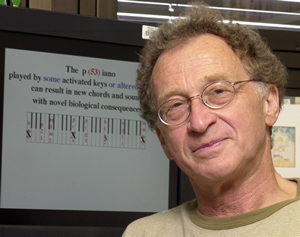
Environmental Factor, September 2008, National Institute of Environmental Health Sciences
Evolutionary Implications for Double-Strand DNA Breaks
By Dixie-Ann Sawin
September 2008

A collaborative study, recently published in the Proceedings of the National Academy of Science by researchers from the NIEHS, Duke University and Brazil’s Universidade Estadual de Campinas determined how DNA double-strand breaks (DSBs) in chromosomes can lead to chromosomal aberrations (CAs) and reshape the genome. In a collaboration between the NIEHS Chromosome Stability Group of Michael Resnick, Ph.D., and the Duke Genetics and Molecular Biology laboratory of Tom Petes, Ph.D., highly sophisticated molecular tools were used to analyze CAs that arose from random DSBs induced by ionizing radiation.
Although the link between ionizing radiation or X-rays and CAs has been known for quite some time, the underlying mechanisms remain unknown. This study highlights the importance of DSBs in creating genetic variation and evolutionary change in organisms. Although DSBs can be efficiently repaired in nearly all organisms, the investigators wanted to know the extent to which they could change the genome even under conditions of maximal repair through homologous recombination (HR).
HR is the process of physical exchange between homologous chromosomes or sister chromatids following replication of a chromosome. This process occurs naturally during chromosomal crossovers in eukaryotic organisms undergoing meiosis and results in a shuffling of genetic material. HR is also involved in repair of DSBs, where organisms repair a damaged region using the material from a partner chromosome as a template. HR can also be utilized as a tool for targeting genetic changes into an organism. HR in eukaryotes has the additional role of protecting organisms from cancer.
This study (http://www.ncbi.nlm.nih.gov/pubmed/18701715?ordinalpos=2&itool=EntrezSystem2.PEntrez.Pubmed.Pubmed_ResultsPanel.Pubmed_RVDocSum) differs from earlier ones because previous studies used techniques that selected for unique types of genetic events at specific chromosomal positions rather than sampling the entire genome. In this study, budding yeast were employed because of their genetic and molecular accessibility and the fact that yeast are often considered as model organisms for understanding events in human cells.
Diploid cells that were arrested in the G2 phase of the cell cycle were exposed to 80 krad (800 Gray) of radiation. This corresponds to 250 DSBs produced per cell. Diploid rather than haploid cells were used because it was anticipated that they could tolerate many types of CAs. Although the majority of DSBs were effectively repaired through HR between sister chromatids or homologous chromosomes, Jim Westmoreland, Ph.D., in the Resnick lab showed that approximately 2% produced CAs. Juan Lucas Argueso, Ph.D., the first author of the paper, showed that most of the generated CAs resulted from HR between small transposable element sequences called Ty retrotransposons that are located across the genome. The CAs were characterized by microarray-based comparative genomic hybridization (CGH array) to identify contiguous genomic segments.
Using a “molecular autopsy” approach that involved CGH of chromosomes newly generated by DSBs, the investigators were able to identify a variety of chromosomal changes. The DSB-induced changes primarily involved recombinational interactions between the Ty elements. These findings show that these scattered sequences could effectively compete with sister chromatids and homologous chromosomes in the HR repair of DSBs. Included among the CAs were deletions, interstitial duplications and nonreciprocal translocations. In addition, mitotic recombination between homologous chromosomes, resulting in loss of heterozygosity (LOH), was also observed. CAs and LOH are common in cancer cells.
This study showed that DSBs can lead to increased genomic plasticity through recombination of repetitive DNA elements. These types of rearrangements can be either advantageous or deleterious to the organism. In fact, as the study suggests, “a compromise between opportunities for variation and excessive genome instability…” may contribute to increased genomic variation in humans.
Citation: Argueso JL, Westmoreland J, Moiczkowski PA, Gawel M, Petes TD, Resnick MA. 2008. Double-strand breaks associated with repetitive DNA can reshape the genome. Proc Natl Acad Sci USA 105(33):11845-11850.
(Dixie-Ann Sawin, Ph.D., is a post-doctoral research fellow in the Laboratory of Neurobiology/Neurotoxicology Group.)
"Expert Panel Conducts..." - previous story ![]()
![]() next story - "Upcoming Distinguished Lecturer..."
next story - "Upcoming Distinguished Lecturer..."
September 2008 Cover Page



